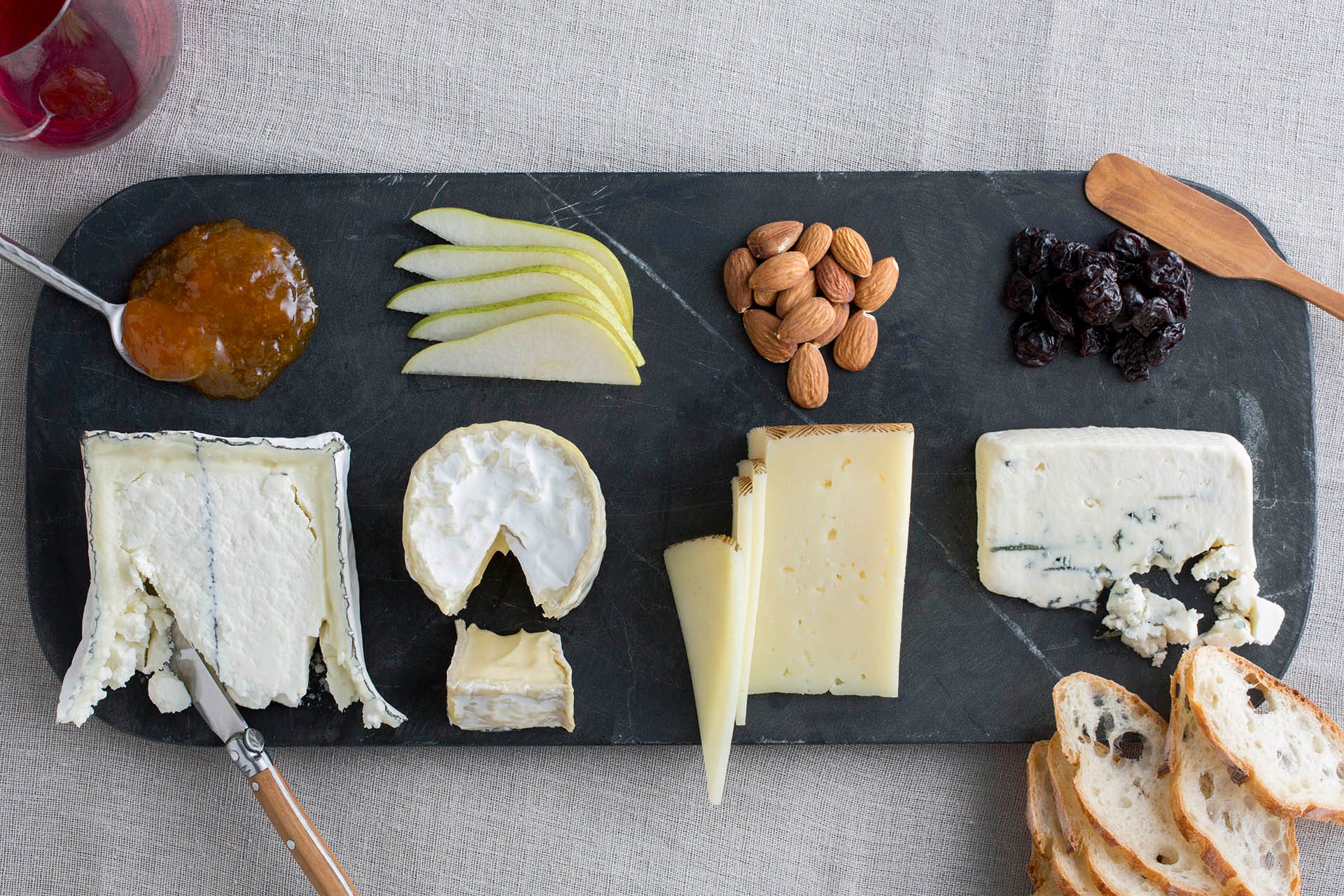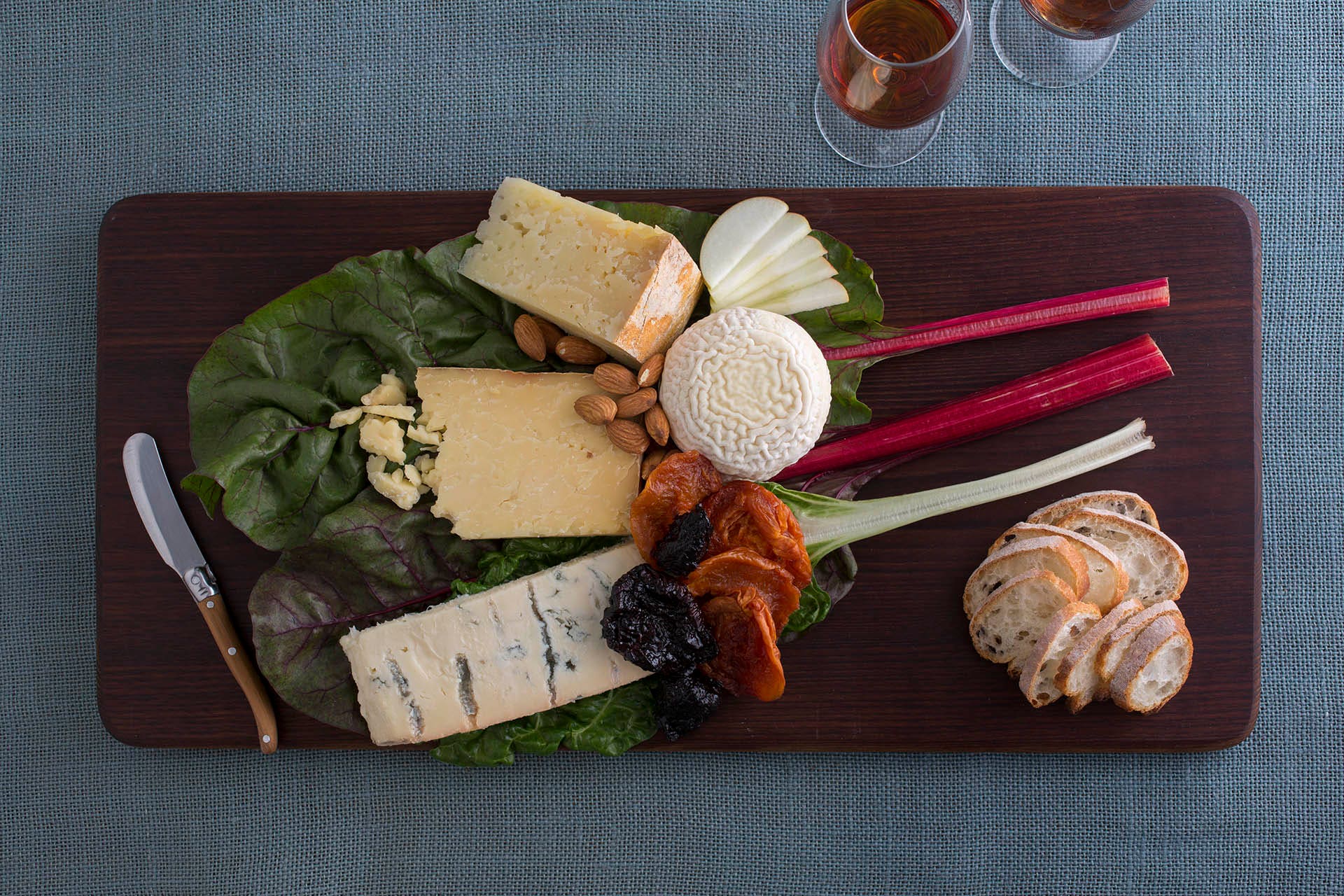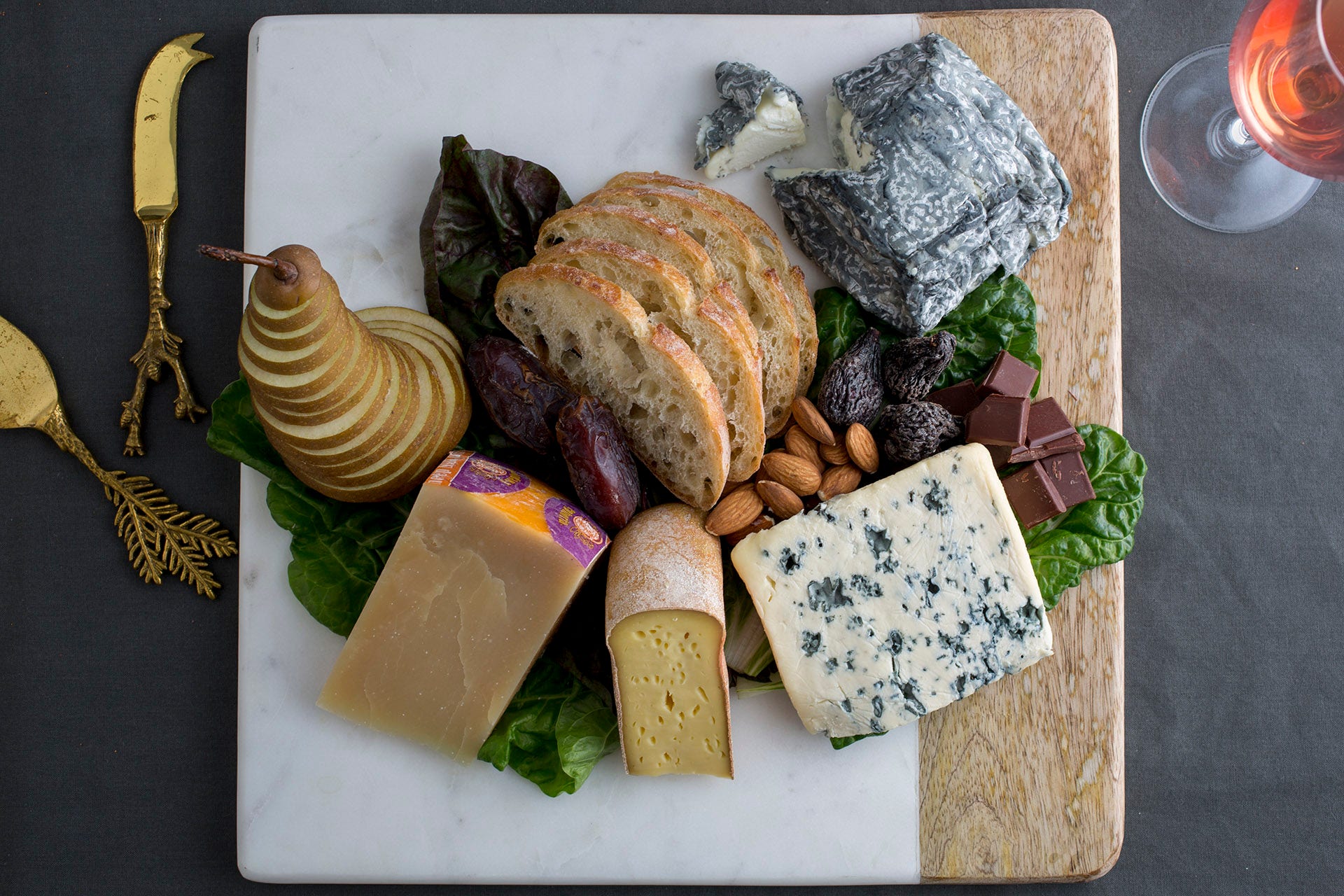The cheese board is where I like to hover at parties. A well-thought slate of dairy goodness can promote conversation and introduce guests to new flavors and unique sensations. A great cheese selection is also an easy way to please a crowd without the hassle of cooking.
But what’s the best way to build a cheese board? Is it better for cheeses to contrast or complement each other? What accoutrements (nuts, jams, fruits, etc.) pair best with different styles of cheese? How should you guide guests from entry-level cheeses to more challenging options?
We’ve assembled a simple guide on how to assemble three perfect cheese boards: an easy-to-build crowd-pleaser for beginners, a slightly more challenging spread for intermediate palates, and a collection of stinky, complex curds for advanced aficionados.
Pears, apricots and apples go great with softer cheeses, while flinty, harder cheeses benefit from the sweetness of jam, compote or jellies.
Sourcing the goods
A good cheesemonger is a beautiful thing, and the best source for cheese is always a counter where it’s cut fresh and wrapped in front of you (I recommend French Cheese Board and Murray’s in New York City). Many varieties of cheese are inoculated with molds and need to breathe to continue the aging process. Pre-cut cheese can be substituted in a pinch, but avoid any with visible condensation or that seems to bulge out of its plastic. Harder, less-fatty cheeses like Parmigiano-Reggiano are an exception.
Budget one ounce of each type of cheese for each guest per hour. Increase that amount if it’s the only snack you’ll offer, or lower it if other food will be served.
Three curated cheese boards
Each of these platters features four cheese types—goat, cow, sheep and blue—in an array of ages and treatments.

The beginner cheese board
The beginner plate features cheeses that are easier to find in stores and will please a wider variety of palates.
• Humboldt Fog: With rind like brie and paste like familiar chèvre logs, this Californian delight has an iconic line of edible vegetable ash down the middle.
• Champlain Valley Triple Cream: Fluffy and with aromas of fresh dough, this cheese boasts a luxurious 70% butterfat content.
• Manchego: Swap out your standard Cheddar block for this Spanish sheep-milk snack.
• Point Reyes Blue: A creamy and salty starter blue that doesn’t sting.
If you can get your teeth through it safely and it tastes good, then you can eat the rind.
Wine pairing for the beginner board: Central Coast Chardonnay
Look to unoaked Chardonnays from California’s Central Coast for an easy sipping wine perfect for cocktail parties or as an aperitif. The apple, pear and citrus flavors typical of the wines will complement this variety of cheeses, with acidity that will cut through the creaminess of the cheese without being astringent.

The intermediate cheese board
For the intermediate plate, go with some more complex curd concepts. You may need to request these choices from a cheesemonger, or you can order them online.
• Coupole: A ripened snowball of goat cheese with a unique, patterned rind.
• Cabot Clothbound Cheddar: This is nothing like the Cheddar you know. Savory, crumbly and sweet, notes of caramel become present as you chew.
• Roncal: A Spanish, raw sheep-milk cheese aged into a meaty masterpiece.
• Gorgonzola Dolce: Scoopable and slick, this cheese tastes like an intense sour cream.
Budget one ounce of each type of cheese for each guest per hour.
Wine pairing for the intermediate board: Loire Valley Pineau d’Aunis or Austrian Zweigelt
While exploring new cheeses take this opportunity to try a wine you may never have had before. Pineau d’Aunis is a red grape known for its peppery flavors and aromas. The reds are made in a lighter style with bright red fruit flavors, mouthwatering acidity and a gentle grip of tannins. While this wine may take some work to find, don’t shy away from Pineau d’Aunis rosés, which will have similar flavors with a little more zip. As an alternative, look to Austrian Zweigelt, which has long been hailed for its crisp red fruit and peppery flavors—a solid choice for a number of pairings.

The advanced cheese board
Advanced selections for adventurers willing to take a chance on the unknown and hunt for their cheeses.
• Valencay: From the Loire Valley, this uniquely shaped cheese was originally molded into a pyramid as an intended gift for Napoleon during his military campaigns in North Africa. After his failures in Egypt, he insisted all tops be sliced off. Slightly aged, this goat cheese brings mineral and citrus notes you won’t get from your standard log of chèvre.
• Meadow Creek Grayson: There’s no two ways about it—this cheese stinks. But keep an open mind and taste for notes of beefy French onion soup.
• Ewephoria: Very similar to an aged Gouda, but with a mysterious finish that can best be described as a flinty Butterfinger candy bar.
• Saint Agur: The muted green veins mold make for a cheese that is spicy, yet creamy—like an easier-to-eat Roquefort.
The best way to arrange cheese isn’t just about the perfect Instagram photo or to impress friends. Visual cues can also help guests navigate the spread.
Wine pairing for the advanced board: Demi-Sec
With so many strong and varied flavors it’s key to select a wine that won’t overwhelm. Demi-sec, or medium-sweet sparkling wines, tend to have delicate fruity and floral flavors while the sugar adds enough intensity that the wine won’t be overwhelmed by the cheese either. Meanwhile, bubbles and acidity will help cleanse and refresh the palate while jumping between the earthy and spicy flavors of the different cheeses.
Tips on plating your cheese board
The best way to arrange cheese isn’t just about the perfect Instagram photo or to impress friends. Visual cues can also help guests navigate the spread.
• Choose a platter that best fits all your cheese. It can be a cutting board, lipless large plate, slate or marble slab. If you’re worried about cleanup afterward, lay down a bed of greens atop your platter like dandelion or chard.
• Knolling is a process to organize items either parallel or 90 degrees from each other. It allows you to see everything on the plate and directs people to pair cheeses with a specific jam or nut.
• Clustering is where cheeses are placed with the rinds facing inward and the pastes (or cut sides) outward, with accoutrements piled in the middle. It inspires looser pairings, which encourages guests to mix and match. “Try this compote with everything, because it’s right there in the middle!” Throw in a few handfuls of toasted nuts, and call it a day.
• While busy, bountiful plates are great visuals, think about how guests can best grab and enjoy their snacks. If another ingredient or garnish provides a barrier, they may give up. When you place selections, consider whether someone can slice downward comfortably and not hit other things.
• Remove all inedible materials like wax rind, twine and cloth from the cheeses. If you can get your teeth through it safely and it tastes good, then you can eat the rind.
• Plate the cheese one hour before your party. They’ll be easier to cut.
• Accompaniments like fresh or dried fruit and toasted nuts increase options and flavor combinations. Pears, apricots and apples go great with softer cheeses, while flinty, harder cheeses benefit from the sweetness of jam, compote or jellies. Blue cheeses taste sinful with dried cherries and/or dark chocolate.
• Provide pre-cut bread and crackers to cleanse palates between bites.
Ready to take it to the next level? Seek out buffalo-milk cheeses. Rich, fatty and a bit more expensive, these are an exciting addition and provide a new world of pairings to explore. Try buffalo mozzarella, Quadrello di Bufala or blu di bufala.
Now it’s your turn. Tag @WineEnthusiast and @Randwiches when you share your finished cheese platter online, and show us what you’ve got.
Jenn de la Vega is a cheese-loving caterer based in Brooklyn, New York, and author of Showdown: Comfort Food, Chili and BBQ.
Last Updated: May 4, 2023















